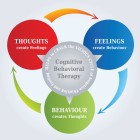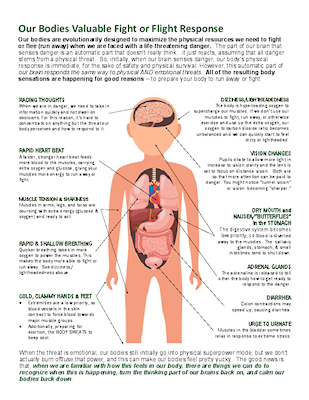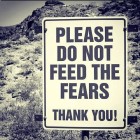All Posts in Category:Trauma
Illustration of (Some) CBT Concepts share
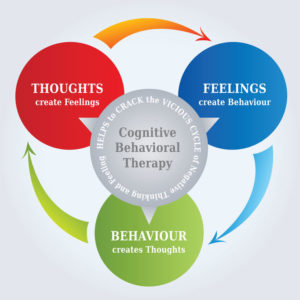 Overview
Overview
Cognitive Behavioral Therapy (CBT) is the strongest, research-backed therapeutic approach in the treatment of anxiety and, additionally, to be very effective for a whole host of other mental health issues. It is based on the framework that emotions, thoughts, and body sensations/physical behavior are at three points of a triangle and intervening on one of the points will result in changes the other two.
TEDx Talk: Feeling Good presented by David Burns, MD – In this YouTube video, David Burns, MD, a well known researcher, clinician, and educator introduces the power of CBT in his warm, humorous and down-to-earth way.
Concepts
“Automatic Thoughts”
Automatic thoughts are a core concept of CBT. They are our brain’s running interior dialogue or self-talk that narrates our life without us even really being aware of that it’s happening until we choose to pay attention to them. If your thoughts frequently contain “thought errors” that are biased to being negative ones, they are very likely to be increasing the level of anxiety or depression that you feel necessarily . These thoughts are habits that reflect the way we interpret things that we do, experience, or even how we view the world. The thing about habits is that, with some work, they can be shifted or changed. When you increase awareness of what your automatic thoughts are, you can start to challenge them and then, ultimately, reduce their effect on your perceptions and your mood. When working with children, negative automatic thoughts that affect them this can sometimes be referred to as a “brain bully.”
- An animated video that talks about automatic thoughts and gives an overview of some of the typical “thought errors” that people might have. Read More >
Thought Errors/Cognitive Distortions
“Focus on the Negative”
Focusing on the negative is known in CBT as a cognitive distortion or “thought error” that can increase the level of anxiety or depression that you feel. The human brain is drawn to negatives but it skews our perception of people and the world around us. With the easy access to negativity in the media, including the internet, it can be more and more challenging to pull our minds away and, instead, choose to focus on the wealth of positive things in our lives. However, the research shows that with practice we can get better at recognizing when we are focusing on only the negative aspects of something and then consciously remind ourselves of all of the positives in the situation instead.
- A playful animated video that illustrates this idea. Read More >
- TED talk that gives a more scientific explanation of how our brains seem to stay stuck on negative information, and how to get unstuck. Read More >
- Story time! At least that’s what our brain is doing when we are experiencing fear for something that might happen in the future. Check out this TED talk and learn more. Hmmm…why might this knowledge be important? Read More >
Healing Yoga share
 Update: 12/16/2018 I just learned that Healing Yoga is closing it’s doors. However, I have decided to leave this article up so that people know that there is such a thing as a yoga/therapy blend that can be very powerful treatment, especially for folks with PTSD. If you are reading this and know of another local resource that offers this type of treatment, please let me know. ~ Andrea
Update: 12/16/2018 I just learned that Healing Yoga is closing it’s doors. However, I have decided to leave this article up so that people know that there is such a thing as a yoga/therapy blend that can be very powerful treatment, especially for folks with PTSD. If you are reading this and know of another local resource that offers this type of treatment, please let me know. ~ Andrea
I’ve written a little about how yoga is an activity that has benefits for for everyone is beneficial for just about everyone. Healing Yoga (Douglassville, PA) takes it one step farther. Recommended to me by a colleague, the instructor, Dorian Abel is a licensed professional counselor who is skilled at incorporating her professional expertise into some of her yoga classes. However, even basic yoga classes should provide wonderful ways to develop skills that benefit a person’s mental well-being. As I write this segment (July ’16), in comparison to prices for yoga classes at other locations that I’ve looked at in the area, her prices are quite reasonable. The individual session fee is definitely more expensive but my suggestion would be, if you are considering that option but are concerned about the expense, it might be possible to do it once as a consultation and then work to incorporate what you learn into your yoga class experience, on your own.
Yoga share
 Yoga is good for the body AND the mind. In addition to the obvious health benefits of regular exercise, a good yoga instructor creates an environment that promotes:
Yoga is good for the body AND the mind. In addition to the obvious health benefits of regular exercise, a good yoga instructor creates an environment that promotes:
- A sense of serenity and acceptance for who you are in the moment.
- Guidance for how you can recognize when your “monkey mind” is swinging from thought to thought with the worries of the day and gently turn your attention back to the present moment and the feeling of your nourishing breath
- Feeling comfortable in your own skin.
- Increasing confidence as your strength and flexibility grows.
There is a TON of research that strongly supports using yoga to assist with the treatment of: anxiety (including Post Traumatic Stress Disorder); depression; ADHD; sleep problems; substance abuse, anger issues, and schizophrenia (when done in conjunction with medication). It’s an activity that can be modified for people of any age, from 2 to 102, and you can take with you anywhere you go! There are even some instructors that have training in both mental health therapy and yoga and can customize the work to really target anxiety and trauma specifically, teaching you how to be comfortable in your own body again.
Personally, my ability to use relaxation breathing as a skill in my daily life has never left me, even though I haven’t done a class for almost 10 years. One day, when my life gets a bit simpler, I fully intend to return to the benefits of a more regular, devoted yoga practice. In the meantime, I remind myself the words of wisdom of one of my former instructors, “Even one sun salutation is a yoga practice.”
TED Talk: How Childhood Trauma Affects Health Across a Lifetime by Nadine Burke Harris, MD share
Dr. Nadine Burke Harris is a pediatrician who explains how repeated stress of abuse, neglect and parents struggling with mental health or substance abuse issues has real, tangible effects on the development of the brain and the body. She calls for, of course, prevention, routine screenings, and using this knowledge to guide medical screenings and interventions.
This information is based on a massive study done by the CDC (Center for Disease Control), that took a look at the potential long-term impact of childhood trauma. You can take a deeper dive into this information on the CDC website.
If you are interested in looking into what your ACES score is, you can see the questionnaire here. ** Important Note: If you have a history of trauma in your life you may feel uncomfortable or get upset when taking this questionnaire. I recommend that you consult with a mental health professional to guide you through this process.
If you found this interesting or helpful, you may also want to check out another post on my site, Oprah Learns about the Life-Long Impact of Developmental Trauma.
Oprah Learns about the Life-Long Impact of Developmental Trauma share
Treating childhood trauma
In the video above, Oprah is getting the word out about about the impact of chronic trauma experienced during a person’s childhood. She is promoting
a piece that she did for 60 minutes that you can watch if you have access to CBS online. In the piece, she learns from trauma expert, Dr. Bruce Perry, that kids who have considerable chronic trauma in their young lives are at significantly higher risk of “almost any kind of physical health, mental health, social health problem that you can think of.” She also learns, that the more people learn about being able to take a “trauma-informed” perspective of people you encounter in the world, the more you can promote healing in others or, at the very least, not add to their struggles.
This information is based on a massive study done by the CDC (Center for Disease Control), that took a look at the potential long-term impact of childhood trauma. You can take a deeper dive into this information on the CDC website.
If you are interested in looking into what your ACES score is, you can see the questionnaire here. ** Important Note: If you have a history of trauma in your life you may feel uncomfortable or get upset when taking this questionnaire. I recommend that you consult with a mental health professional to guide you through this process.
If you found this interesting or helpful, you may also want to check out another post on my site, TED Talk: How childhood trauma affects health across a lifetime by Nadine Burke Harris, MD.
Crime Victims’ Center of Chester County share
 The Crime Victims’ Center of Chester County, Inc. provides free and confidential services to victims and their family members/significant others who reside in or were victimized in Chester County, Pennsylvania. They make the cold and unwelcome world of the court system feel knowable and as effective as possible by practically, and sometimes literally, holding your hand every step of the way. Additionally, free counseling and even money towards expenses that have resulted from being a victim are also available.
The Crime Victims’ Center of Chester County, Inc. provides free and confidential services to victims and their family members/significant others who reside in or were victimized in Chester County, Pennsylvania. They make the cold and unwelcome world of the court system feel knowable and as effective as possible by practically, and sometimes literally, holding your hand every step of the way. Additionally, free counseling and even money towards expenses that have resulted from being a victim are also available.
Since I originally wrote this post, I have now had personal experience with this organization and I can’t say enough good things about them. If you are the victim of a crime, they should be the second place, that you call, after the police/FBI. Even if you are unsure or don’t want to formally report your the crime to the authorities, CVC is there for you, 24-hours/day.
CVC, also known as the Rape Crisis Council of Chester County, Inc., is the designated Sexual Assault Center for Chester County. CVC provides services to victims of all types of crime and violence including, but not limited to: rape, sexual assault, incest, sexual harassment, child abuse, elder abuse, homicide, assault, robbery, identity theft, drunk driving, stalking, and bullying.
Tip: If you don’t live in Chester County, your county will have a crime victims’ center too, but perhaps by a different name. A quick Google search should be able to help you locate the one in your area.
Panic Attacks Part 1: What is Panic & Why We Need It share
Panic is a normal, necessary physical response to the brain perceiving a significant threat. It involves the release of a hormone that you are likely familiar with, adrenaline. Adrenaline’s job is to tell the body to make chemical changes in the body so that the body is physically primed to either fight or flee/run away, from the threat. These can be things such as:
- Rapid heartbeat
- Short, shallow breaths
- Paling or flushing (can switch between both)
- Digestion slows down or stops (becomes a low priority for your body)
- Constriction of blood vessels in many parts of the body…including the BRAIN (which interferes with your ability to think logically)
- Dilation of blood vessels for muscles (so they are ready for action)
- Take energy from stored nutrients to fuel muscles
- Dilation of pupils
- Temporary loss of hearing
- Tunnel vision (loss of peripheral vision)
- Physical shaking

Back in the day of the caveman, the people who didn’t have a panic response were much less likely to survive because their bodies were not as prepared to deal with a physical threat. Our body’s ability to quickly maximize all of our resources for survival is a critical aspect not only of humans but all animal species. Yet, in our Western culture, many of us are fortunate that our safety is not regularly threatened in a physical way. Instead, because our brain does not recognize a difference between a physical threat and emotional threat, in a modern society a panic response can often be triggered by things such as fear of embarrassment or fear that a bridge might collapse. Or, perhaps you do have experience with your physical safety being at risk and now, your body is in hyper-vigilant mode and looking for danger at every corner.
The problem here is that our body’s physical readiness to fight or run won’t help us to not be embarrassed. Nor will it help us cross a perfectly well-maintained bridge or walk around the corner in a typically safe neighborhood. Instead, that physical response can feel scary itself and physically uncomfortable if we don’t do anything to burn off that energy and bring our body back to calm. Additionally, increasing our breathing rate without making use of the extra oxygen we are taking in creates a chemical imbalance between the oxygen and carbon dioxide levels of our body that adds to our feelings of physical discomfort.
So, what can we do if we start to physically panic about a possible emotional threat? Check out the next article in this series!
Remaining articles in this series:
- Panic Attacks Part 2: The Antidote to Panic – Relaxation Breathing
- Panic Attacks Part 3: Fear of the Fear – Don’t Let Panic Attacks Take Over Your Life
- Panic Attacks Part 4: Time To Tune Into Your Early Warning System (coming soon)
Panic Attacks Part 2: The Antidote to Panic - Relaxation Breathing share
Previous article in this series:
- Panic Attacks Part 1: What is Panic & Why We Need It
Relaxation breathing is the antidote to panic. Literally. It is impossible to be truly breathing in a relaxed way and to be experiencing a full-blown panic attack at the same time. This is because relaxation breathing helps to reset our body chemistry to a “normal” state and bring it out of panic. If you haven’t read it yet, the previous article in this series, Panic Attacks Part 1: What is Panic & Why We Need It, you might want to check it out.
Some people may tell you that there is a “right way” to do relaxation breathing. In my opinion, if you try the “right way” and you find it to be really annoying and just plain won’t do it, then clearly that is not the right way for you. Generally, the recommendation is that you are breathing out for a longer count than you are breathing in and that you are taking in air by expanding your belly muscles, not your chest muscles.
My recommendation is that you find something that feels comfortable for you and go with that approach. No matter which approach you choose, the most important thing is that you practice relaxation breathing every day when you are already calm. I cannot stress this point enough. When your body is in panic mode, learning a new skill is not something that your brain is going to be very good at. So if you’re heading into a panic attack and you haven’t been practicing your relaxation breathing, don’t be surprised if it doesn’t work to help you return to calm…yet.
Regardless of the breathing technique that you decide to use, I recommend that you practice your relaxation breathing during a time that you are already relatively calm and relaxed, for five minutes at a time, a minimum of 1-2 times every day, with one of those times being at night when you are lying down to fall asleep. The main goal is to be able to clear your mind of all thought and just focus on the sensation of your breath going in and out of your body. Or, you can add some sort of positive phrase that you can repeat to yourself if it helps. (For example: “Breathe in calm. Breathe out fear,” but it could be anything so long as you interpret it as positive and relaxing.)
Below is a video that describes square breathing and then, below that, a few other informational links. The video is geared towards kids but you can use whatever imagery you like, and, who doesn’t enjoy the smell of fresh baked cookies?? (You’ll understand that last comment when you watch the video.)
Additional Breathing Information:
- Another take on square breathing, including a printable that you can download and customize.
- Diaphragmatic breathing, also known as “belly breathing,” which can be blended with square breathing if you’d like.
If you have a smart phone, there are also plenty of free apps that you can download to help coach you through relaxation breathing. Here are two that I’ve had experience with:
- Breathe2Relax – availabe on iPhone and Android (I recommend adjusting the default settings to what is comfortable for you.)
- Centered – available on iPhone only 🙁
Remaining articles in this series:
- Panic Attacks Part 3: Fear of the Fear – Don’t Let Panic Attacks Take Over Your Life
- Panic Attacks Part 4: Time To Tune Into Your Early Warning System (coming soon)
Panic Attacks Part 3: Fear of the Fear - Don't Let Panic Attacks Take Over Your Life share
Previous articles in this series:
- Panic Attacks Part 1: What is Panic & Why We Need It
- Panic Attacks Part 2: The Antidote for Panic & Relaxation Breathing
Panic attacks feel very intense when you have them. At best, it’s not a comfortable feeling. At worst, it feels very scary because your body feels like it’s out of control. Some people even worry that they are having a heart attack. If you are experiencing these symptoms for the first time, definitely talk with a medical professional to rule out any medical causes before treating the symptoms as a panic attack. This is important for two reasons. The first is that you need to get a proper diagnosis. The second is that if you are constantly worrying that you are having a heart attack…that’s going to increase your anxiety and make successfully treating panic very difficult.
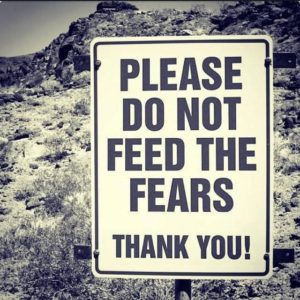 Once you know that your body is healthy and ok, it’s time to dig in to the emotional aspects that come into play with panic and anxiety. When you worry too much about the possibility that you might have a panic attack, then this worry itself can become the trigger for your next panic attack. I call this having “fear of the fear (that it will happen again).” With the use of acceptance, information, “growth mindset,” and skill development, here are some guidelines that work against the negative spiral that can happen when people start to develop a “fear of the fear.” This article assumes that you already have started working on developing the skills for turning around a panic attack and is part 3 of a four-part series of articles I hope to complete. Hopefully, I’ll get part 4 up soon!
Once you know that your body is healthy and ok, it’s time to dig in to the emotional aspects that come into play with panic and anxiety. When you worry too much about the possibility that you might have a panic attack, then this worry itself can become the trigger for your next panic attack. I call this having “fear of the fear (that it will happen again).” With the use of acceptance, information, “growth mindset,” and skill development, here are some guidelines that work against the negative spiral that can happen when people start to develop a “fear of the fear.” This article assumes that you already have started working on developing the skills for turning around a panic attack and is part 3 of a four-part series of articles I hope to complete. Hopefully, I’ll get part 4 up soon!
- Recognize that this is a new situation for you and, because of that, it makes sense that it’s hard in the beginning to figure out what’s happening and how best to manage it. Also, know that you’re not alone. There are many people who have or are currently going through this too.You are having, what is called, a panic attack. [Growth Mindset]
- Remember that fight or flight mode is a normal thing that our bodies do. The only problem is that it’s getting triggered when you don’t actually need to respond physically to an emotionally stressful situation. The most important thing to know here is, NO HARM WILL COME TO YOUR BODY AS YOU EXPERIENCE IT (your body physically revving up to fight or flee). It does feel yucky to be in physical panic mode. This is especially true because your body, in that moment, is primed with an abundance of energy to physically react and that means that you experience temporary physical changes to your body (i.e. increased heart rate, quick & shallow breathing, increased blood circulation to muscles, decreased blood circulation to the “rational” part of your brain, and more), but your body naturally knows how to shift out of this mode when the perception of a physical threat is gone. [Watch this great video about how the US government has learned to train Navy SEALS not to panic.]
- Accept that this is not your last panic attack. What I’m saying here is find a way to be ok with knowing that it will happen again AND that should one happen and your growing relaxation and cognitive skills can’t turn it around, you can ride it out until it’s done and be still be ok. In general, the goal is for the panic attacks to start reducing in intensity as you get better at turning them around but this won’t happen if you avoid panic attacks, or things that might cause them, rather than face them. [Acceptance]
- Continue to experiment with and practice various relaxation techniques (relaxation breathing is the most important one for panic) and good self care habits so that you can hone your skills and have more “tools” in your “toolbox” when the need arises. [Skill Development]
- Work on developing cognitive strategies that can help prevent panic attacks from happening or intervene at the early signs of panic so that you can prevent a full blown physical response. [Skill Development]
- Keep a list of things that help turn your panic attacks around so that you can refer to the list the next time. [Skill Development]
- Remembering that low blood sugar, hypoglycemia, can mimic the beginning feelings of a panic attack, carry a healthy snack with you that has a nice combination of protein and complex carbs. [Check out this podcast by Dr. Kristen Allot about why this is so incredibly important.]
- Minimize or, ideally, eliminate caffeine. Drink water. Enjoy water. Did I mention water? [Information]
Remaining article in this series:
- Panic Attacks Part 4: Time To Tune Into Your Early Warning System (coming soon)
TEDx Talk: Feeling Good presented by David Burns, MD share
Cognitive Behavioral Therapy (CBT) is based on the premise that our thoughts, emotions, and behavior are all interrelated and affect one another. Because of this, if we learn to identify when we are having “thought errors” that distort our perception of reality, often skewing to seeing things in more a negative light, we can then Dr. David Burns is a well known researcher, clinician, and public speaker. He is one of the leaders in the development of CBT, having been trained personally by CBT’s founder, the world-renowned Aaron T. Beck, MD. In this short video, Dr. Burns uses stories from his life experience both as a clinician and as a person, to illustrate the power of CBT and how working to change our thoughts, in a real and genuine way, can have a profoundly positive effect on how we feel. CBT has become the strongest (most likely to succeed), “evidence-based” form of therapy for issues such as depression and Bipolar Disorder, various forms of anxiety (PTSD, phobias, Obsessive-Compulsive Disorder), eating disorders, and substance use disorders. This means that scientific research has been able to document that CBT really works for people.

